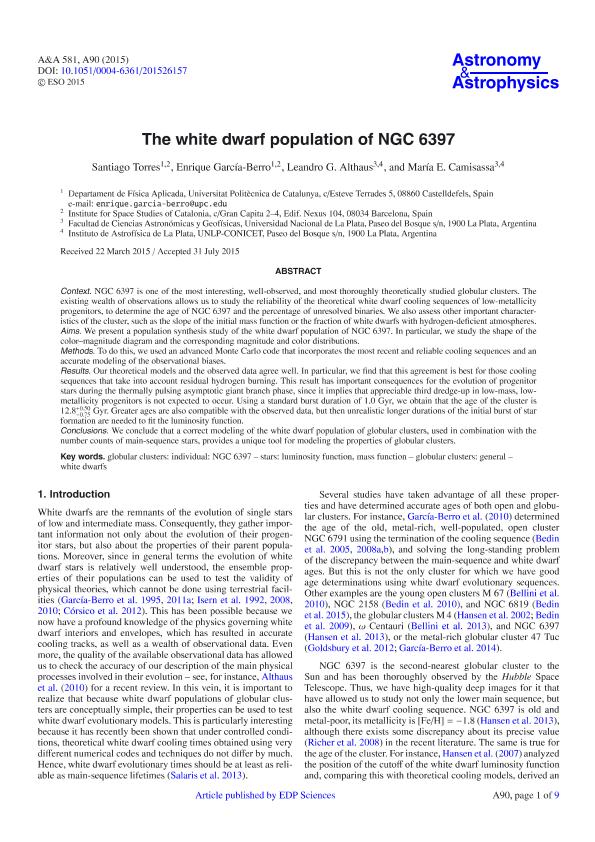Mostrar el registro sencillo del ítem
dc.contributor.author
Torres, Santiago
dc.contributor.author
García Berro, Enrique
dc.contributor.author
Althaus, Leandro Gabriel

dc.contributor.author
Camisassa, Maria E.
dc.date.available
2017-01-05T17:49:51Z
dc.date.issued
2015-09
dc.identifier.citation
Torres, Santiago; García Berro, Enrique; Althaus, Leandro Gabriel; Camisassa, Maria E.; The white dwarf population of NGC 6397; Edp Sciences; Astronomy And Astrophysics; 581; 9-2015; 1-90; A90
dc.identifier.issn
0004-6361
dc.identifier.uri
http://hdl.handle.net/11336/10876
dc.description.abstract
Context: NGC 6397 is one of the most interesting, well-observed, and most thoroughly theoretically studied globular clusters. The existing wealth of observations allows us to study the reliability of the theoretical white dwarf cooling sequences of low-metallicity progenitors, to determine the age of NGC 6397 and the percentage of unresolved binaries. We also assess other important characteristics of the cluster, such as the slope of the initial mass function or the fraction of white dwarfs with hydrogen-deficient atmospheres.
Aims: We present a population synthesis study of the white dwarf population of NGC 6397. In particular, we study the shape of the color–magnitude diagram and the corresponding magnitude and color distributions.
Methods: To do this, we used an advanced Monte Carlo code that incorporates the most recent and reliable cooling sequences and an accurate modeling of the observational biases.
Results: Our theoretical models and the observed data agree well. In particular, we find that this agreement is best for those cooling sequences that take into account residual hydrogen burning. This result has important consequences for the evolution of progenitor stars during the thermally pulsing asymptotic giant branch phase, since it implies that appreciable third dredge-up in low-mass, lowmetallicity progenitors is not expected to occur. Using a standard burst duration of 1.0 Gyr, we obtain that the age of the cluster is 12.8+0.50 −0.75 Gyr. Greater ages are also compatible with the observed data, but then unrealistic longer durations of the initial burst of star formation are needed to fit the luminosity function.
Conclusions: We conclude that a correct modeling of the white dwarf population of globular clusters, used in combination with the number counts of main-sequence stars, provides a unique tool for modeling the properties of globular clusters.
dc.format
application/pdf
dc.language.iso
eng
dc.publisher
Edp Sciences

dc.rights
info:eu-repo/semantics/openAccess
dc.rights.uri
https://creativecommons.org/licenses/by-nc-sa/2.5/ar/
dc.subject
White Dwarf
dc.subject
Stellar Evolution
dc.subject
Ngc 6397
dc.subject
Luminosity Function
dc.subject
Mass Function
dc.subject.classification
Astronomía

dc.subject.classification
Ciencias Físicas

dc.subject.classification
CIENCIAS NATURALES Y EXACTAS

dc.title
The white dwarf population of NGC 6397
dc.type
info:eu-repo/semantics/article
dc.type
info:ar-repo/semantics/artículo
dc.type
info:eu-repo/semantics/publishedVersion
dc.date.updated
2017-01-02T18:36:54Z
dc.identifier.eissn
1432-0746
dc.journal.volume
581
dc.journal.pagination
1-90; A90
dc.journal.pais
Francia

dc.journal.ciudad
Paris
dc.description.fil
Fil: Torres, Santiago. Universidad Politecnica de Catalunya; España. Instituto de Estudios Espaciales de Cataluña; España
dc.description.fil
Fil: García Berro, Enrique. Universidad Politecnica de Catalunya; España. Instituto de Estudios Espaciales de Cataluña; España
dc.description.fil
Fil: Althaus, Leandro Gabriel. Consejo Nacional de Investigaciones Científicas y Técnicas. Centro Científico Tecnológico La Plata. Instituto de Astrofísica de La Plata; Argentina. Universidad Nacional de la Plata. Facultad de Ciencias Astronómicas y Geofísicas; Argentina
dc.description.fil
Fil: Camisassa, Maria E.. Consejo Nacional de Investigaciones Científicas y Técnicas. Centro Científico Tecnológico La Plata. Instituto de Astrofísica de La Plata; Argentina. Universidad Nacional de la Plata. Facultad de Ciencias Astronómicas y Geofísicas; Argentina
dc.journal.title
Astronomy And Astrophysics

dc.relation.alternativeid
info:eu-repo/semantics/altIdentifier/doi/http://dx.doi.org/10.1051/0004-6361/201526157
dc.relation.alternativeid
info:eu-repo/semantics/altIdentifier/url/http://www.aanda.org/articles/aa/abs/2015/09/aa26157-15/aa26157-15.html
dc.relation.alternativeid
info:eu-repo/semantics/altIdentifier/url/https://arxiv.org/abs/1507.08806
Archivos asociados
